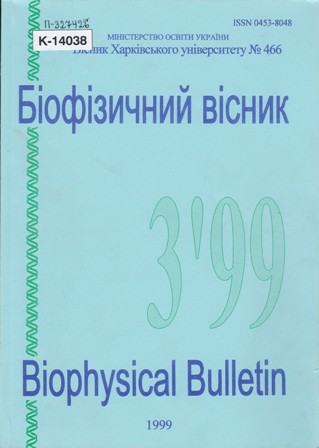RELAXATION AND SPECTROSCOPIC MANIFESTATIONS OF HYDRATION OF POLYRIBOCYTIDYLIC ACID
Abstract
Hydration and structure state of polyribocytidylic acid (poly(rC)) have been studied in solutions and humid films. The role of water in forming different structures of poly(rC) was elucidated, hi solutions, the hydration values of single-strand (pH 4.5), double-strand (pH 7.8) and disordered (pH 3.3) forms of poly(rC) were determined with a differential EHF-dielectrometer using the measurements of dielectric permittivity at wavelength7.6 mm. In humid films, distribution of water molecules on the hydration sites for these structures has been found with IR spectroscopy. Hydration models of the single and double-strand structures of poly(rC) were developed using X-ray and these data.
KEY WORDS: polycytidylic acid, hydration, infrared spectra, millimeter region, structural transitions.
Downloads
References
2. V.Ya. Maleyev, M.A. Semenov, A.I. Gasan, V.A. Kashpur, "Physical Properties of the DNA-Water System", Biofizika, Vol.38, No.5,pp.789-811, 1983.
3. T. Umehara, S. Kuwabara, S. Mashimo, S. Yagihara, «Dielectric Study on Hydration of B-, A- and Z-DNA», Biopolymers, Vol.30, No.7/8, pp.649-656,1990.
4. C.H. Chou, G.J. Thomas, «Raman Spectral Studies of Nucleic Acids», Biopolymers, Vol.16, No.4, pp.765-789, 1977.
5. M.A. Semenov, B.I. Sukhorukov, V.Ya. Maleyev, "Are Nitrogen Bases of DNA Hydrated at Low Humidity?", Biofizika, Vol.26, No.6, pp.979-984, 1981.
6. V.A. Kashpur, V.Ya. Maleyev, T.Yu. Shchegoleva, "Investigation of Hydration of Globular Proteins by Differential Dielectrometric Method", Моl. Biol, Vol.10, No.3, pp.568-575,1976.
7. T.J. Buchanan, G.M. Haggis, L.B. Hasted, "The Dielectric Estimation of Protein Hydration", Proc. Roy. Soc, A213, No.1114,pp.379-391,1952.
8. L.I. Antropov, "Theoretical electrochemistry", Moscow, pp.568,1975.
Authors who publish with this journal agree to the following terms:
- Authors retain copyright and grant the journal right of first publication with the work simultaneously licensed under a Creative Commons Attribution License that allows others to share the work with an acknowledgement of the work's authorship and initial publication in this journal.
- Authors are able to enter into separate, additional contractual arrangements for the non-exclusive distribution of the journal's published version of the work (e.g., post it to an institutional repository or publish it in a book), with an acknowledgement of its initial publication in this journal.
- Authors are permitted and encouraged to post their work online (e.g., in institutional repositories or on their website) prior to and during the submission process, as it can lead to productive exchanges, as well as earlier and greater citation of published work (See The Effect of Open Access).





